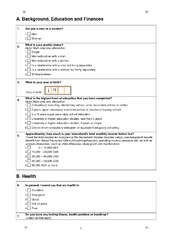| dc.contributor.author | Ármannsdóttir, Brynja | en_US |
| dc.contributor.author | Mårdby, Ann-Charlotte | en_US |
| dc.contributor.author | Haukenes, Inger | en_US |
| dc.contributor.author | Hensing, Gunnel | en_US |
| dc.date.accessioned | 2014-07-11T08:10:03Z | |
| dc.date.available | 2014-07-11T08:10:03Z | |
| dc.date.issued | 2013-04-10 | eng |
| dc.identifier.issn | 1471-2458 | |
| dc.identifier.uri | https://hdl.handle.net/1956/8123 | |
| dc.description.abstract | Background: Sickness absence is a public health problem with economic consequences for individuals and society. Although sickness absence and chronic diseases are correlated, few studies exist concerning the role of chronic disease in all-cause sickness absence. The aim was to assess the cumulative incidence of sickness absence and examine the accompanying burden of chronic diseases among the sick-listed. Methods: A cross-sectional study was performed with data from 2008. Cumulative incidence of all-cause sickness absence (≥14 days) was calculated based on all newly sick-listed individuals (N = 12,543). The newly sick-listed sample and a randomized general population sample (n = 7,984) received a questionnaire (participation rates: 54% and 50%).To assess the burden of self-reported chronic diseases, standardized incidence ratios (SIR) were calculated. Results: Estimated one-year cumulative incidence was 11.3% (95% CI: 11.2–11.3), 14.0% (13.9–14.1) for women and 8.6% (8.5–8.6) for men. Gender differences were consistent across all age groups, with highest cumulative incidence among women aged 51–64 years, 18.2% (18.0–18.5). For women, the burden of chronic disease was significantly higher for nine out of twelve disease groups, corresponding numbers for men were nine out of eleven disease groups (standardized for age and socio-economic status). Neoplastic diseases had the highest SIR with 4.3 (3.4–5.2) for women and 4.2 (2.8–5.6) for men. For psychiatric and rheumatic diseases the respective SIR’s were 1.7 for women and 1.8 for men. The remaining disease groups had an elevated risk of 20-60% (SIR 1.2–1.6). The risk of reporting a co-morbidity was increased for women (SIR 1.4 (95% CI 1.4–1.5)) and men (SIR 1.5 (1.4–1.7)) among the sick-listed. Conclusions: Register data was used to estimate of the cumulative incidence of sickness absence in the general population. A higher burden of chronic disease among the newly sick-listed was found. Targeting long-term health problems may be an important public health strategy for reducing sickness absence. | en_US |
| dc.language.iso | eng | eng |
| dc.publisher | BioMed Central | eng |
| dc.rights | Attribution CC BY | eng |
| dc.rights.uri | http://creativecommons.org/licenses/by/2.0 | eng |
| dc.subject | Sickness absence | eng |
| dc.subject | Incidence | eng |
| dc.subject | Chronic disease | eng |
| dc.subject | Gender | eng |
| dc.subject | Socioeconomic status | eng |
| dc.title | Cumulative incidence of sickness absence and disease burden among the newly sick-listed, a cross-sectional population-based study | en_US |
| dc.type | Peer reviewed | |
| dc.type | Journal article | |
| dc.date.updated | 2013-08-23T08:52:06Z | |
| dc.description.version | publishedVersion | en_US |
| dc.rights.holder | Copyright 2013 Ármannsdóttir et al.; licensee BioMed Central Ltd. | |
| dc.rights.holder | Brynja Ármannsdóttir et al.; licensee BioMed Central Ltd. | |
| dc.source.articlenumber | 329 | |
| dc.identifier.doi | https://doi.org/10.1186/1471-2458-13-329 | |
| dc.identifier.cristin | 1038302 | |
| dc.source.journal | BMC Public Health | |
| dc.source.40 | 13 | |


